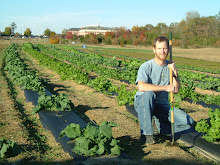 This is "twin row" peanut. Planting peanuts in twin rows is a common practice, although it is just as often planted in single rows. The idea is that twin rows fit more plants per acre, and therefore increase yield per acre, but it requires special (and expensive) implements.
This is "twin row" peanut. Planting peanuts in twin rows is a common practice, although it is just as often planted in single rows. The idea is that twin rows fit more plants per acre, and therefore increase yield per acre, but it requires special (and expensive) implements. This was the coolest thing I saw today on the tour. This is the same twin row peanut as the first photo. It's worth clicking on the photo above to see what i'm talking about here.
This was the coolest thing I saw today on the tour. This is the same twin row peanut as the first photo. It's worth clicking on the photo above to see what i'm talking about here.To the lower right, the black tube is called drip tape. It delivers water directly to the plant roots, thereby increasing water use efficiency (no evaporation loss), which is particularly important during these times of drought and high energy prices (running the pumps more = more $$$). You can also inject fertilizer directly to the roots as well.
But that's not the coolest part. These are PEANUTS. That means they need to be dug out of the ground. Imagine spending all winter installing this system, not to mention the boatloads of money, only to hook one of your drip tape lines and rip the system up! Pretty scary if you're a farmer. So this drip tape is buried at about 12 inches, while peanuts will be dug at about 8 inches. That leaves a 4 inch margin of error. Imagine if you had a few inches of erosion, or if you sunk a tractor wheel a few inches while digging...
In order to make certain that you dig in the same exact place year after year, you need GPS RTK technology on your tractors. (More $$$.) GPS on your tractors allows you to exactly maximize your land use, as well as apply variable fertilizer rates across the field as the crops need it (after downloading satellite data to determine which parts of the field need what rates of fertilizer), and a bunch of other "precision agriculture" applications.
Does it work? If you look at the photo, you'll see the roots of the peanut actually tend toward the drip tape. Remember, we're in a drought here in the southeastern US, for the third year in a row. So where there's water, there's roots. Roots are amazing like that. They'll "search out" favorable conditions, whether it's a better pH, or more nutrients, or, in this case, water.
Water is the best fertilizer!
 This is conservation tillage peanut. Conservation tillage is defined as having at least 30% soil coverage after planting, which helps increase organic matter content in soil.
This is conservation tillage peanut. Conservation tillage is defined as having at least 30% soil coverage after planting, which helps increase organic matter content in soil. This photo shows conventional till cotton on the left, and conservation till on the right. Easy to see the difference here.
This photo shows conventional till cotton on the left, and conservation till on the right. Easy to see the difference here. Center pivot irrigation, in case you've never seen it before.
Center pivot irrigation, in case you've never seen it before. The hanging water spigots here gets the water closer to the ground, thereby limiting evaporation (it gets hot here) by getting the water closer to the ground. Profits are so slim as a producer, every cent per acre is money in your pocket.
The hanging water spigots here gets the water closer to the ground, thereby limiting evaporation (it gets hot here) by getting the water closer to the ground. Profits are so slim as a producer, every cent per acre is money in your pocket. And here's a picture of some cotton flowers, in case you wondered what they look like. You can see that they are first a kind of pink, and then mature to a big white, beautiful flower.
And here's a picture of some cotton flowers, in case you wondered what they look like. You can see that they are first a kind of pink, and then mature to a big white, beautiful flower.



